 Hello,
Hello,
I have made some peach wine and apricot wine from my orchard. I would like for them to taste a little more like peach or apricot. Suggestions?
Thanks
Darlene
—–
Good Morning Darlene,
Since these wines have already been made we have to look at things we can do to them irrespective of the wine recipes used to make them. This pretty much narrows the options down to direct flavoring adjustments or flavoring enhancement.
One of the wine making products we have that can be used to enhance a wine’s flavor is our liqueur flavorings. These are flavorings that are intended to be mixed with plain vodka to instantly make anything from an orange brandy to peppermint schnapps. We have had great success with using them to enhance various fruit wine recipes.
The brand is called Top Shelf Liqueur Flavorings. They come in very small bottles, but pack a very big punch of flavor to a fifth of vodka. I would suggest adding the Apricot Brandy and the Peach Schnapps flavorings respectively to your wines.
You should need no more than one bottle to 5 gallons of wine. You may want to only add half a bottle to start out with and see how that goes. Make sure the flavor enhancer gets blended thoroughly when adding. Then let the wine sit overnight before bothering with sampling a taste. For some reason it seems that these flavorings need to mingle a bit with the wine before their full flavor comes into fruition.
A second way to enhance your wine recipes is to sweeten the wine. Many wines loose their fruitiness as they become drier from the fermentation. Dry essentially means lack of sweetness. By adding back sweetness before bottling, you can often bring back the fruitiness of the wine.
A third way to enhance your wine recipes is to both sweeten and enhance the wine at the same time by adding frozen concentrate to them. For your two wines in particular, you could use peach and apricot frozen concentrates–the same stuff you get at the grocery store.
It is important to note that if you do add any kind of sugar/sweetener to the wine, you will also need to add another one of our wine making products, Potassium Sorbate, to keep the wine from re-fermenting and becoming dry again.
Happy Wine Making
Customer Service
Watch for my next blog post (Part II) where I will explain how you can tweak your wine recipes to get the most fruit flavor you can in them even before you add the yeast.
———————————————————————————————————
Ed Kraus is a 3rd generation home brewer/winemaker and has been an owner of E. C. Kraus since 1999. He has been helping individuals make better wine and beer for over 25 years.
Category Archives: Wine
Crushing And Pressing Red Wine Grapes
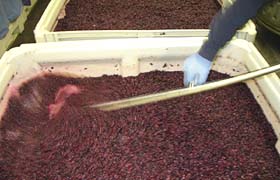 Hello E. C. Kraus:I’ve read a lot of the articles on your site concerning wine making. The one titled “Wine Making With Grapes” mentions that there is a different method of processing red grapes than there is for white grapes, but I’m not sure I completely understand the process for red grapes. What does it mean when it says that they are to be “crushed and fermented with the skin and pulp for several days and then later pressed”?
Hello E. C. Kraus:I’ve read a lot of the articles on your site concerning wine making. The one titled “Wine Making With Grapes” mentions that there is a different method of processing red grapes than there is for white grapes, but I’m not sure I completely understand the process for red grapes. What does it mean when it says that they are to be “crushed and fermented with the skin and pulp for several days and then later pressed”?—–
Hello Henry,
You are correct. The information on how to make white wine is different than the information on making reds. Let us see if we can clear up some of the confusion.
Fermenting red grapes with the pulp and skin means crushing the grapes and gathering the pulp into a primary fermenter along with all of the other wine making ingredients. You follow this process for red wine in order to extract more color and body from the grape. This post, What’s The Skins Got To Do With It, that is listed on this wine making blog will provide you with more information.
Customer Service at Adventures in Homebrewing
———————————————————————————————————
Ed Kraus is a 3rd generation home brewer/winemaker and has been an owner of E. C. Kraus since 1999. He has been helping individuals make better wine and beer for over 25 years.
How To Handle That Last Bit Of Sediment
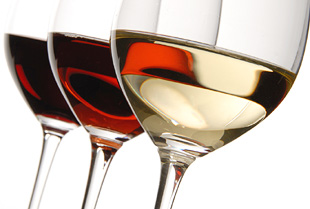 Hi,
Hi,
I have been making wine from homemade wine kits for about a year now and have a question about the sediment just when I am ready to bottle the wine. Sometimes I do another rack back to my plastic fermenter to clear out some of the sediment; however, there is always a little in the bottom. Should I buy a wine filter or just siphon the wine down to the sediment and disregard the stuff? Is the wine filter designed to filter out wine sediment and to clarify cloudy wine?
Thanks again,
Bill
———-
At this point in the wine making process it is best to siphon down to the sediment and lose some of the wine. The loss should be very minimal at this point.
One thing you can do to help make the last siphoning (racking) more efficient is to slightly tilt the plastic fermenter before siphoning the wine. This will allow you to corner some of the wine and siphon more up. The sediment should not move with it, but rather, stay in place, stuck against the bottom.
You can get a wine filter and filter the wine, but these filters are not designed for taking out visible sediment. Their wine filter pads are extremely fine and will clog up quickly if there is very much sediment at all in the wine.
Wine filters are more designed toward taking a wine clear wine and adding a polish to it. Obviously, if there is just a light dusting in the bottom of the plastic fermenter this will not be a problem, but even if the wine looks only slightly murky, or if there is more than a dusting of sediment, you may not get a 6 gallon batch of wine through a single set of filter pads.
My final advice to you would be, when making wine with one of these homemade wine kits, expect to lose a little wine at the last racking. It shouldn’t be much, maybe a cup or so. If you want to get a wine filter system, then fine, go ahead, but don’t do it for the purpose of clearing out visible sediment. Do it to give the wine a more polished, brilliant appearance.
Happy Wine Making
Customer Service
———————————————————————————————————
Ed Kraus is a 3rd generation home brewer/winemaker and has been an owner of E. C. Kraus since 1999. He has been helping individuals make better wine and beer for over 25 years.
Don't Waste The Wine. Use A Fining Agent.
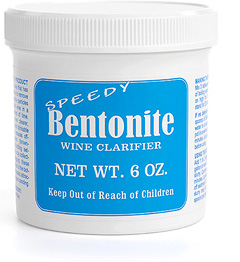 Gentlemen:
Gentlemen:
Is there a secret, or product, that will help the sediment settle more before racking? Is it usual to have a large amount of sediment; it seems such a waste of wine to discard it all.
Thank you very much. I enjoy your website and the email newsletter and am loving our attempts at winemaking!!!
Thanks again.
Sincerely,
Jean D.———-
Hello Jean,
Glad to hear you are having so much fun learning how to make your own wine. We try to help people out as much as we can with info and various wine making tips. Your question a is one we get quite often.
There are wine making products that will help to clear up the wine better and pack down the sediment more. They are called fining agents and are routinely used by wineries.
The particular fining agent I would recommend for your wine is call bentonite. We sell it as Speedy Bentonite. It will collect and drag out the particles suspended in the wine and pack it to the bottom. As the name implies, it does the job very quickly. Treating your wine a day or two before transferring it off the sediment [racking] will allow you to save more wine.
Here’s another one of my wine making tips that will save you a lot of wine as well: It is important to understand is that it is not necessary to eliminate all of the sediment with each racking of the wine. It is only important to leave most of the sediment behind. Always get as much of the wine as you can. Don’t leave any behind, even if some sediment is coming with it.
The only exception to this is the vary last racking, before bottling. This is the racking where you have to be more critical. But by the time you get to this racking there should only be a dusting of sediment, so little wine will be lost.
You may want to take a look at the article, Racking Your Wines: The When’s, Why’s and How’s, listed on our website. This will have better detail on the subject of racking your wine.
Thank you for such a great question. This is an area of wine making where many beginning winemakers have a problem.
Happy Wine Making
Customer Service
———————————————————————————————————
Ed Kraus is a 3rd generation home brewer/winemaker and has been an owner of E. C. Kraus since 1999. He has been helping individuals make better wine and beer for over 25 years.
Where Can I Find A Stone Crock For Making Wine?
 Hello Kraus,
Hello Kraus,
I’m hoping you can help me. Do you know where I can get a stone crock? I just broke the one I was going to use. We have a lot of elderberries this year and I don’t want to see them go to waste. I need to get my wine brewing.
Thank You Very Much
Tim B.———-
Hello Tim,
I’m very sorry, but we do not have a source for stone crocks.
I would like to point out that a stone crock is not necessary for making wine. In fact, stone crocks are rarely used these days for making wine. Today, home winemakers use plastic fermenters and carboys (water jugs). These items are commonly available at any winemaking shop and are easier to use than a stone crock.
The main advantage with these fermenting containers over a stone crock is that they can be sealed with an air-lock or water trap to effectively protect the wine from any airborne contaminants. It’s hard to keep wine safe in a stone crock.
A second issue is the ability to sanitize the stone crock. With plastic fermenters and carboys you simply treat them with a solution of sodium metabisulfite.
This method works fine with stone crocks too, but only if the inside glazing is not cracked. Most stone crocks you find today have been used and have these aged cracks. The inner depths of these cracks are impossible sanitize completely and become breeding-grounds for various bacteria, particularly if the crock has been used for making sauerkraut or vinegar, previously.
Add all this up with the additional fact that stone crocks are fragile and cumbersome to move, and it starts to become apparent that using carboys and plastic fermenters is a much more convenient and safer way to make wine.
Happy Wine Making
Customer Service
———————————————————————————————————
Ed Kraus is a 3rd generation home brewer/winemaker and has been an owner of E. C. Kraus since 1999. He has been helping individuals make better wine and beer for over 25 years.
Residue In My Bottles Of Wine
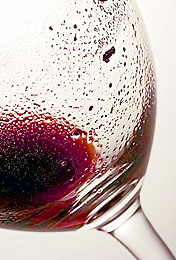 Hello:
Hello:
I have been having problems with residue in my bottles of rhubarb, choke cherry, pear and plum wine but have never had a problem with my wild grape, plum or even choke cherry before.
Bottled three weeks ago and the only one with no residue is my wild grape. Will unbottle and redo if you think it’s warranted.
Thank you in Advance
Mike
———-
Hello Mike,
It sounds like there is one of two things you could do to eliminate the residue problem from occurring in the future. First, you could try treating all your wines with bentonite. This is a clarifier that helps to drag out particles that will eventually fall out later in the bottle.
If you don’t want to use bentonite, then you should consider aging your wine in bulk for 6 months or better before actually bottling. Once the wine is completely done fermenting, give it a couple of weeks to initially clear up. Then move it into wine carboys or some other type of glass jugs. Seal them up with either cork stoppers or rubber stoppers. Also be sure to wire them down so that they don’t pop out on their own.
That same residue that is occurring in your wine bottles is what will be showing up in your wine carboys as sediment after a few months. Once all the sediment is no longer getting worse, you can then bottle the wine. It’s all about giving the wine plenty of time to drop out all particles before bottling.
As far as the residue you now have in the wine bottles, it will not hurt anything. I would recommend consuming the wine, as is, but if you do decide to rebottle, I would recommend also adding a dose of sodium metabisulfite directly afterwords to reduce the effects of air exposure when rebottling.
Best Wishes,
Customer Service at E. C. Kraus
———————————————————————————————————
Ed Kraus is a 3rd generation home brewer/winemaker and has been an owner of E. C. Kraus since 1999. He has been helping individuals make better wine and beer for over 25 years.
Why Is My Wine So Bubbly?
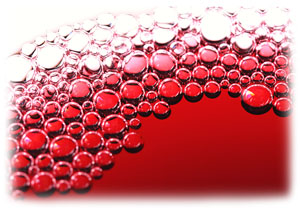 Hello:
Hello:
I’m getting ready to bottle my wine and noticed that it has a bubbly taste. Like champagne. Is this because I need to degas it? Or is there something else going on?
Ken
———-
Hello Ken,
It is very possible that you are correct in your assumption. The wine may simply need to be degassed. But you should also verify with a gravity hydrometer that the wine has actually completed its fermentation. It is possible that the bubbles you are experiencing are from a slight, but still active, fermentation.
When first learning how to make your own wine you want to get into the habit of double-checking that the fermentation has actually completed with a gravity hydrometer. Sometimes fermentation’s will stop before they are done.
If you do not know how to use a gravity hydrometer to check your wine, the article, Getting To Know Your Hydrometer, listed on our website, will give you an over view of the gravity hydrometer and its use.
If you have already determined that a slight fermentation is not the cause of your bubbly wine, then more than likely it is left-over, remnant CO2 gas from the fermentation. Putting the wine through a degassing process will be your answer.
There are a lot of ways to go about degassing a wine. You can siphon the wine back and forth between a couple of glass jugs in a splashing manner. Or, you can dump the wine back and forth between a couple of plastic fermenters. But both these methods introduce a lot of air into the wine. This is something you don’t want to do at this stage. It will promote the oxidation of your wine.
A safer way to go about it is to use a degassing paddle. A degassing paddle will agitate the wine without splashing it. This dramatically reduces the effects of oxidation. It attaches to a power drill, just like a drill bit, so it takes very little effort to use. The paddle blades also fold up so that they will fit into the small opening of a wine carboy.
Happy Wine Making
Customer Service at E. C. Kraus
———————————————————————————————————
Ed Kraus is a 3rd generation home brewer/winemaker and has been an owner of E. C. Kraus since 1999. He has been helping individuals make better wine and beer for over 25 years.
Testing The Alcohol Level Of A Finished Wine
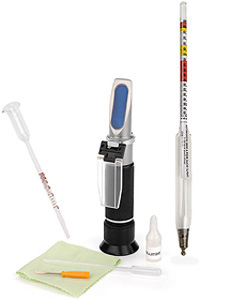 Hi Kraus,
Hi Kraus,
What kind of alcohol tester other the vinometer can I buy to measure the alcohol of my finished homemade wine?
Thanks Joshua
———-
Dear Joshua,
Of all the wine making products that exist, the vinometer is the only one that home winemakers can practically use to test the final alcohol level of a finished wine. It is somewhat accurate when testing a dry wine, but if your wine has any residual sugars, the reading will be thrown way off.
Most wineries rely on a refractometer and/or a gravity hydrometer to determine the alcohol level of a wine. They are both very accurate and easy to use. The drawback is they both require that you take two readings, one before the fermentation and another after.
If you forget or miss taking the first reading, you will not be able to determine the finished alcohol level. The two readings of either the refractometer or gravity hydrometer need to be compared to determine the alcohol level.
There are other ways of testing the alcohol in a wine beside using the vinometer, refractometer or gravity hydrometer, however this brings us into the realm of laboratory equipment and is left for only the larger wineries to practically afford.
Best Wishes,
Customer Service
———————————————————————————————————
Ed Kraus is a 3rd generation home brewer/winemaker and has been an owner of E. C. Kraus since 1999. He has been helping individuals make better wine and beer for over 25 years.
Should I Use The Juice Or The Pulp?
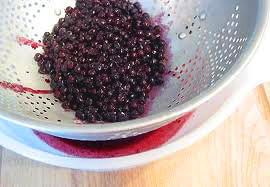
Hello-
I’ve never made wine; but, I’m slowly acquiring the wine making materials. I would like to make fruit wines mostly plum and perhaps strawberry and peach.
From what I’ve been reading it seems that either one starts with juice and does the whole fermentation process that way or that one ferments the chopped up raw fruit contained in a bag for a week or so and then continues the fermentation process in a different container less the pulp.
My question is: Will the wine be better tasting if one ferments the pulp of raw fruit or will it be better tasting if one extracts the juice of the raw fruit first presumably by cooking with a and straining or by using a steam juicer?
Thank you.
Joe
———-
Hello Joe,
When making wine with your own fruit, to achieve optimal flavor, color and body, we recommend fermenting with the pulp and skin. This is what provides most of the color and body. You can use a steam juicer to extract the juice, but you should still keep the pulp in with the fermentation for the first 5 to 7 days.
The only argument for leaving the skin and pulp out of the fermentation would be if you are trying to achieve a light-bodied wine. An example of this would be apple wine.
This is no different than how professional wineries approach making wine. In general, with red grapes they run them through the grape crusher then ferment them before running them through the grape presses. With white grapes, they crush and press before fermenting.
Best Wishes,
Customer Service at Adventures in Homebrewing
———————————————————————————————————
Ed Kraus is a 3rd generation home brewer/winemaker and has been an owner of E. C. Kraus since 1999. He has been helping individuals make better wine and beer for over 25 years.
Does Freezing The Fruit Wipe Out The Funk?
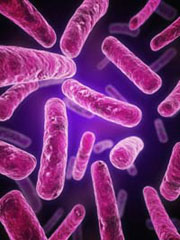 Quick question,
Quick question,
If you have frozen fruit (like I do) for months do you need to use Sodium Metabisulfite when you start the wine brewing process or does the freezing kill all the bad stuff.
Thanks,
Steven
———-
Hello Steven,
Unfortunately, freezing does not destroy mold, bacteria or other “bad stuff”. It simply puts its growth into suspension, or hibernation if you like. Freezing will damage some of the cells with freezer-burn, but not nearly enough to save your fruit from needing a sulfite treatment of some kind. You will still need to add sodium metabisulfite before using it to make wine.
Even though freezing does not eliminate potential spoilage, it does temporally stop the spoilage process. This is great for someone trying to save up enough grapes to make some homemade grape wine.
Often in a small backyard vineyard, the grapes will not ripen evenly throughout the rows. In this situation you can freeze what ripens early until you have enough saved to make a batch of wine. Just realize that you will still need to add sodium metabisulfite to the batch before fermentation and again, before bottling, regardless if the grapes have been frozen or not.
I hope this answers your question. Nothing wrong with freezing fruit. It just doesn’t eliminate the need for sulfites.
Best Wishes,
Customer Service
———————————————————————————————————
Ed Kraus is a 3rd generation home brewer/winemaker and has been an owner of E. C. Kraus since 1999. He has been helping individuals make better wine and beer for over 25 years.
